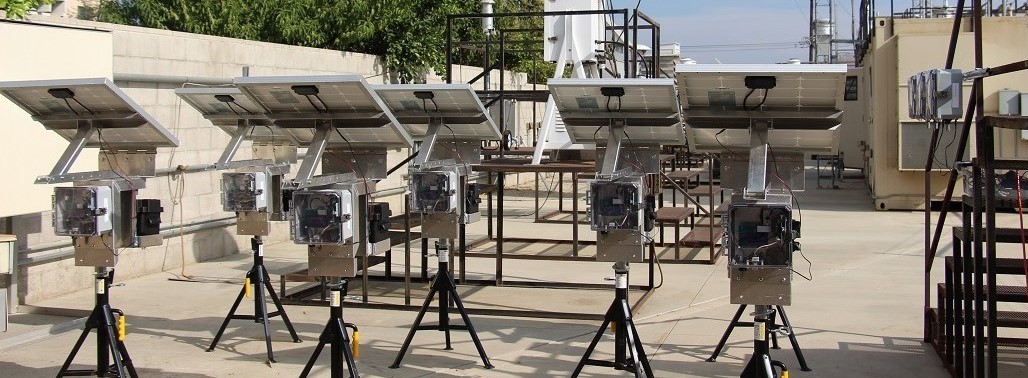sensortoolkit - Air Sensor Data Analysis Library

Sensors at an ambient air monitoring site. Photo Credit - South Coast AQMD AQ-SPEC Program
Disclaimer
The United States Environmental Protection Agency (EPA) GitHub project code is provided on an “as is” basis and the user assumes responsibility for its use. EPA has relinquished control of the information and no longer has responsibility to protect the integrity , confidentiality, or availability of the information. Any reference to specific commercial products, processes, or services by service mark, trademark, manufacturer, or otherwise, does not constitute or imply their endorsement, recommendation or favoring by EPA. The EPA seal and logo shall not be used in any manner to imply endorsement of any commercial product or activity by EPA or the United States Government.
Overview
Library Description
sensortoolkit is a Python library for evaluating air sensor data. The library is intended for use with sensors collocated at ambient air monitoring sites alongside FRM/FEM monitors for comparison and analysis of sensor data against reference-grade data.
sensortoolkit can be used to evaluate sensor data for a single or multiple sensors measuring one of the following pollutants: PM1, PM2.5 [criteria], PM10 [criteria], CO [criteria], NO, NO2 [criteria], NOx, O3 [criteria], SO2 [criteria], SOx.
sensortoolkit is most suitable for individuals who have some prior coding experience in python. The library is equipped with an API (application programming interface) that allows for ease of navigation and customization, making sensortoolkit accessible to individuals with a wide range of skillsets (e.g., individuals interested in monitoring their own sensor data, students and academic researchers, and industry professionals).
Key Features
The primary goal of sensortoolkit is to provide a platform for analyzing air sensor data regardless of formatting differences across sensor data formatting schemes. This goal extends to reference data as well, and interactive setup modules are included for interpreting the recorded format for datasets for subsequent ingestion into standardized formatting schemes for sensor and reference data.
Import sensor data via a standardized ingestion process and interactive setup module
Average to 1-hour and/or 24-hour averaging intervals.
Import FRM/FEM reference data from a variety of sources, including ingestion modules for importing data from AirNowTech, and modules for querying either the AQS or AirNow API services.
Submit queries for single or multiple parameters, parse datasets into a consistent reference data format and save unmodified and processed datasets to a data directory.
Conduct analysis with the SensorEvaluation module
Compute U.S. EPA’s recommended performance metrics for evaluating PM2.5 and O3 sensors.
Visualize sensor performance with various figures and save to file location.
Sensor vs. FRM/FEM scatter plots
Timeseries indicating both sensor and FRM/FEM concentrations
Performance metric results and comparison against target values/ranges.
Save performance evaluation results, statistics, and supplemental information detailing the deployment conditions to a deployment JSON file.
Create testing reports using U.S. EPA’s base-testing report template (PowerPoint file) with the PerformanceReport module.
Additional modules are included for calculating quantities (AQI, PM2.5 NowCast, application of sensor correction equations, the U.S. Wide correction equation for PurpleAir sensors via Barkjohn et al. 2021 1, etc.) and conducting additional analysis (quality control modules for identifying outliers, invalidation of datapoints, A&B channel cleaning for PurpleAir data via Barkjohn et al. 2021 1, etc.)
Access to modules utilized by the SensorEvaluation and PerformanceReport for greater customization in conducting analysis.
Footnotes
- 1(1,2)
Barkjohn, K. K., Gantt, B., and Clements, A. L.: Development and application of a United States-wide correction for PM2.5 data collected with the PurpleAir sensor, Atmos. Meas. Tech., 14, 4617–4637, https://doi.org/10.5194/amt-14-4617-2021, 2021.
U.S. EPA’s Performance Targets Reports
In February 2021, U.S. EPA released two reports outlining recommended performance testing protocols, metrics, and target values for fine particulate matter (PM2.5) and ozone (O3) air sensors used in non-regulatory, supplemental, and informational monitoring (NSIM) applications.
The sensortoolkit library includes numerous modules for computing performance metrics recommended by U.S. EPA for evaluating (PM2.5) and ozone (O3) sensors. Additionally, plotting functions are included for visualizing performance evaluation results, including visualization of sensor performance metric values against U.S. EPA’s performance targets, sensor time series, scatter plots comparing collocated sensor and reference measurements, distribution plots for displaying the range of meteorological conditions during the deployment, etc. Tabular statistics and figures can be automatically compiled into testing reports recommended by U.S. EPA’s performance targets documents for testing conducting at ambient air monitoring sites.
Note
Presently, evaluation of sensor performance with sensortoolkit using U.S. EPA’s recommended performance metrics and target values is limited to PM2.5 and O3.
FRM/FEM data may not be available at all testing sites for non-criteria pollutants (PM1, NO, NOx, SOx, etc.). Testers should ensure that sensors are collocated alongside reference instrumentation capable of reporting 1-hour and/or 24-hour concentration values for evaluation parameters of interest.